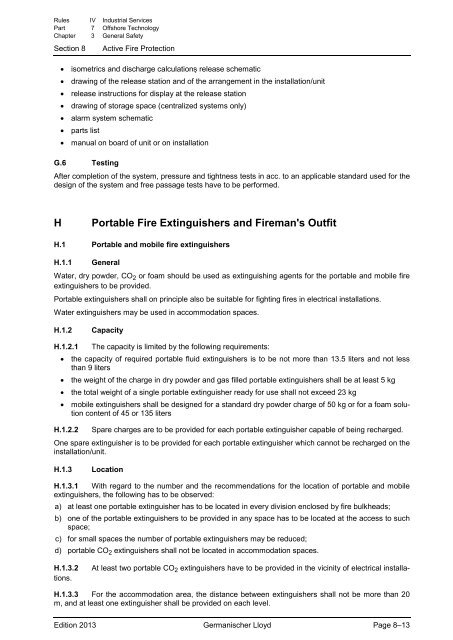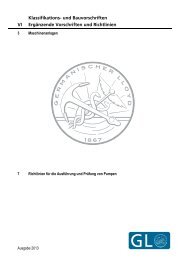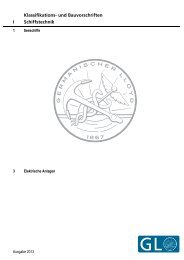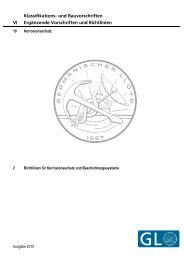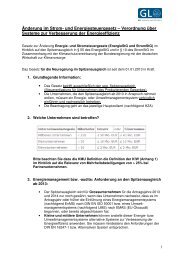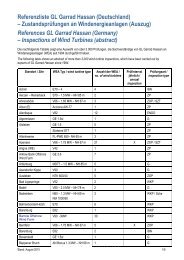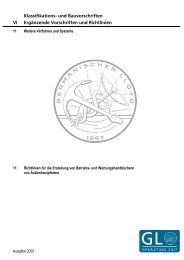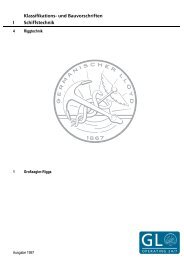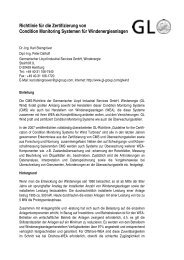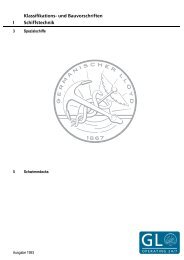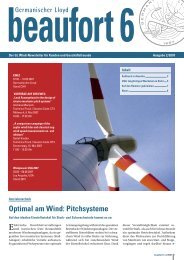(IV-7-3) General Safety
(IV-7-3) General Safety
(IV-7-3) General Safety
Create successful ePaper yourself
Turn your PDF publications into a flip-book with our unique Google optimized e-Paper software.
Rules <strong>IV</strong> Industrial Services<br />
Part 7 Offshore Technology<br />
Chapter 3 <strong>General</strong> <strong>Safety</strong><br />
Section 8<br />
Active Fire Protection<br />
• isometrics and discharge calculations release schematic<br />
• drawing of the release station and of the arrangement in the installation/unit<br />
• release instructions for display at the release station<br />
• drawing of storage space (centralized systems only)<br />
• alarm system schematic<br />
• parts list<br />
• manual on board of unit or on installation<br />
G.6 Testing<br />
After completion of the system, pressure and tightness tests in acc. to an applicable standard used for the<br />
design of the system and free passage tests have to be performed.<br />
H<br />
Portable Fire Extinguishers and Fireman's Outfit<br />
H.1 Portable and mobile fire extinguishers<br />
H.1.1 <strong>General</strong><br />
Water, dry powder, CO 2 or foam should be used as extinguishing agents for the portable and mobile fire<br />
extinguishers to be provided.<br />
Portable extinguishers shall on principle also be suitable for fighting fires in electrical installations.<br />
Water extinguishers may be used in accommodation spaces.<br />
H.1.2<br />
Capacity<br />
H.1.2.1 The capacity is limited by the following requirements:<br />
• the capacity of required portable fluid extinguishers is to be not more than 13.5 liters and not less<br />
than 9 liters<br />
• the weight of the charge in dry powder and gas filled portable extinguishers shall be at least 5 kg<br />
• the total weight of a single portable extinguisher ready for use shall not exceed 23 kg<br />
• mobile extinguishers shall be designed for a standard dry powder charge of 50 kg or for a foam solution<br />
content of 45 or 135 liters<br />
H.1.2.2 Spare charges are to be provided for each portable extinguisher capable of being recharged.<br />
One spare extinguisher is to be provided for each portable extinguisher which cannot be recharged on the<br />
installation/unit.<br />
H.1.3<br />
Location<br />
H.1.3.1 With regard to the number and the recommendations for the location of portable and mobile<br />
extinguishers, the following has to be observed:<br />
a) at least one portable extinguisher has to be located in every division enclosed by fire bulkheads;<br />
b) one of the portable extinguishers to be provided in any space has to be located at the access to such<br />
space;<br />
c) for small spaces the number of portable extinguishers may be reduced;<br />
d) portable CO 2 extinguishers shall not be located in accommodation spaces.<br />
At least two portable CO 2 extinguishers have to be provided in the vicinity of electrical installa-<br />
H.1.3.2<br />
tions.<br />
H.1.3.3 For the accommodation area, the distance between extinguishers shall not be more than 20<br />
m, and at least one extinguisher shall be provided on each level.<br />
Edition 2013 Germanischer Lloyd Page 8–13


